FARMING UPDATE



INTRODUCTION
Welcome to the July 2024, Ceres Rural Farming Update, a publication that provides independent insights on agricultural issues, reports on policy, grant and administrative updates and key market information.





Welcome to the July 2024, Ceres Rural Farming Update, a publication that provides independent insights on agricultural issues, reports on policy, grant and administrative updates and key market information.

In our previous publication it was noted that the data for the Early Bird Survey was gathered in November and therefore, may not be a true reflection of what is on the ground. In what has been one of the wettest winters on record, winter sowing plans were completely dismantled.
In response to the above, the AHDB took the pragmatic approach to re-run the survey in February to ensure that the reality on the ground was captured. As AICC contributors to the survey, Ceres Rural has assisted in ensuring this much needed intervention was made.
As expected, the discrepancy between autumn plans and what was on the ground by the spring is stark. This re-run Early Bird Survey shows considerable falls in winter cropping, including wheat, winter barley and oilseed rape, without accounting for crop condition. Naturally, this led to an increase in spring cereal area, showing a 10% increase in barley and oats compared to plans in the autumn. Once again, the rise in ‘Arable Fallow’ area is staggering. In November, the year-on-year % increase was 25%, which has now risen three-fold to 79% in just the four-month period between surveys. The table overleaf shows the results of the re-run Early Bird Survey 2024 conducted by AHDB.
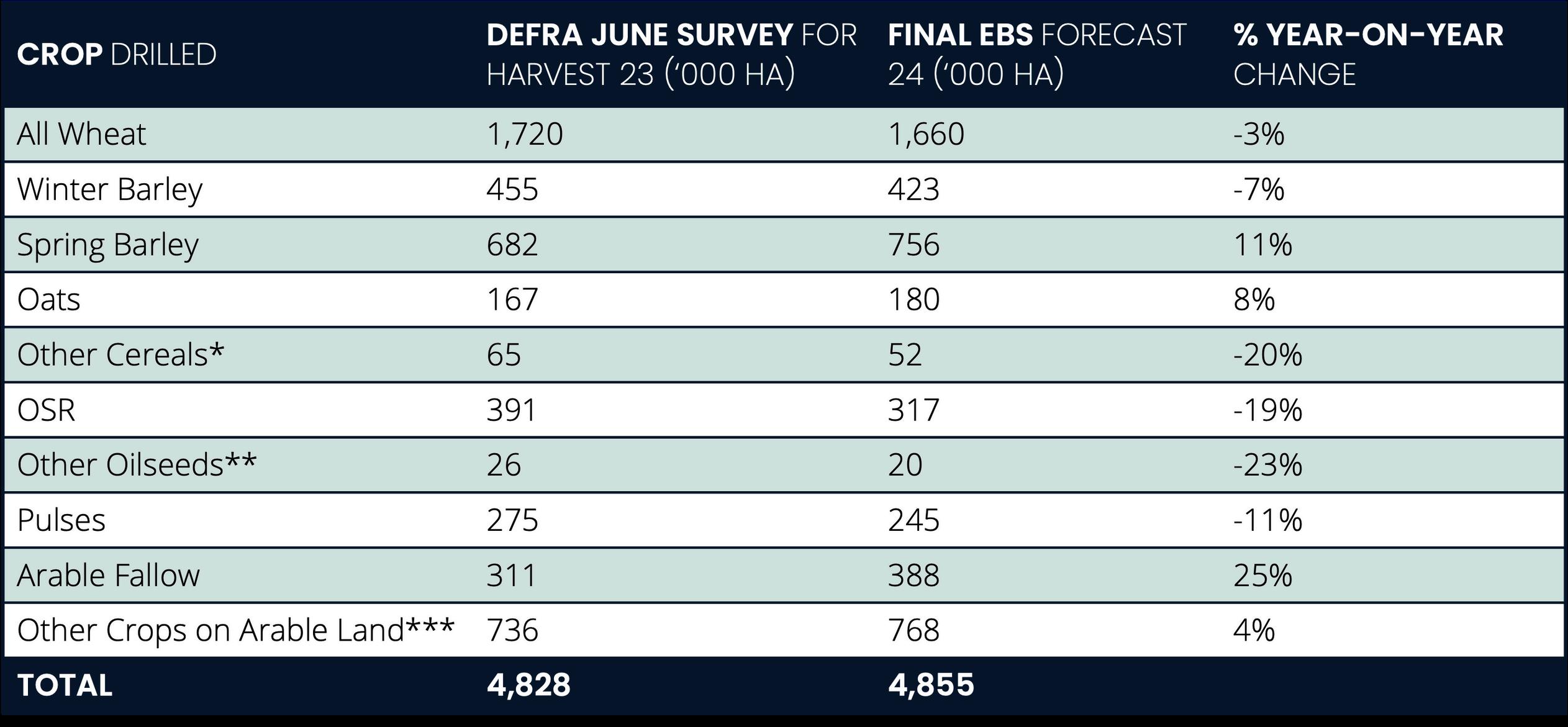
*Cropsincludedrye,triticaleandmixedgrains
**Cropsincludedlinseedandborage
***Cropsincludedsugarbeet,potatoes,vegetables,maize(33%)andtemporarygrass(20%)
Source:Defra,TheAndersonsCentrefortheAHDB
As we head into harvest, it seems an appropriate moment to review the weather and reassure ourselves that it really has been the trickiest growing season for many years! Reaching top yields is a product of establishing a plant population which has access to both an adequate level of moisture and energy from sunlight.
Looking at a growing season that starts in September and concludes in August and using Met Office data for East Anglia from the turn of the century, we can see the following:
Rainfall: There has been a total of 693mm. This is ranked 5th with two months still to go, showing that the quantity of rainfall has been quite considerable. Assuming an average level of rainfall for July and August, the 2024 harvest would be the 2nd wettest since 2000 – we shall have to wait and see. What is also pertinent is that every month, other than June, has been wetter than average. 3

Temperature: interestingly, we have seen an incredibly mild start to the year, with the months of February, March and May all ranking within the top 2 warmest months of this century. This might go some way, coupled with rainfall events, to explaining the level of disease pressure experienced. Sunshine: in relative terms, the months of February, March and April were all 20% down on sunshine hours. Although this isn’t as comprehensive a measure as sunlight intensity, one could probably assume they go hand in hand. Fortunately, the month of June is up 20% on average, hence everything is still to play for.
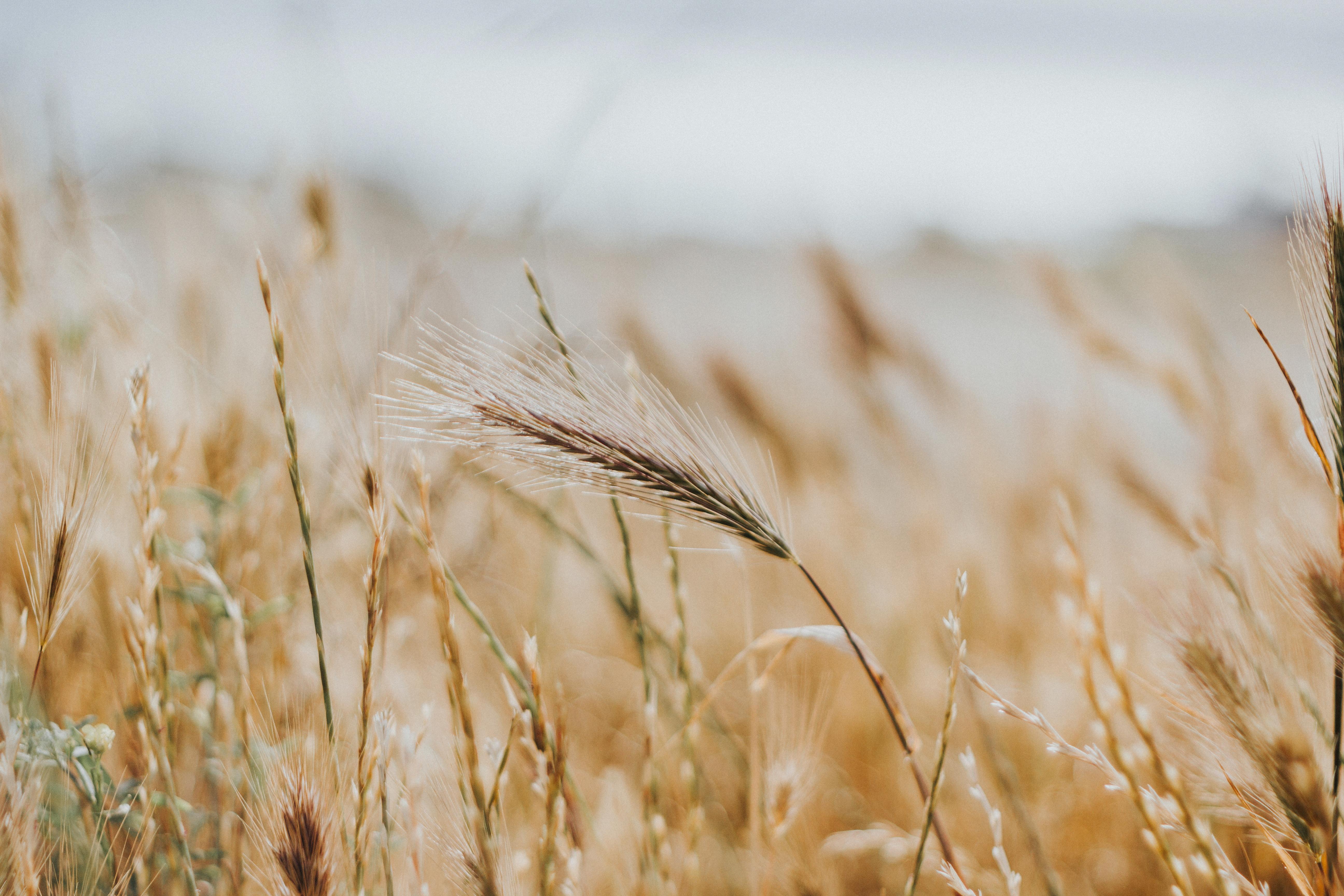
All things considered, growers in the South East are in a better place with their winter cereals than would have been expected six months ago. Where establishment was compromised, the wheat has shown an incredible ability to put out more tillers, and barer areas have filled themselves in.
Generally speaking, there are reasonable stands of wheat and winter barley to be harvested across our region. Despite the upturn in plant survival and establishment, the wet weather has significantly impacted the effective use of pesticides. Very few growers were able to treat for Barley Yellow Dwarf Virus (BYDV) and stunted patches are evident in the crop where infection has occurred.
Grass weeds were always going to be a challenge given the inability to execute a full residual herbicide programme in the autumn; however, it is alarming how many late germinating grasses have appeared above standing in the crop. Given the continued prospect of wet weather, growers might consider pre-harvest glyphosate in crops badly burdened to decrease seed viability and improve cutting.
Despite many being forced into growing spring cereals this season, they are looking very well. Delayed drilling has meant the crops are clean for weeds and disease, and continued moisture has allowed them to generate lots of leaf material and maintain good green area. These crops will now require good levels of sunshine to transition them to grain fill and quality.
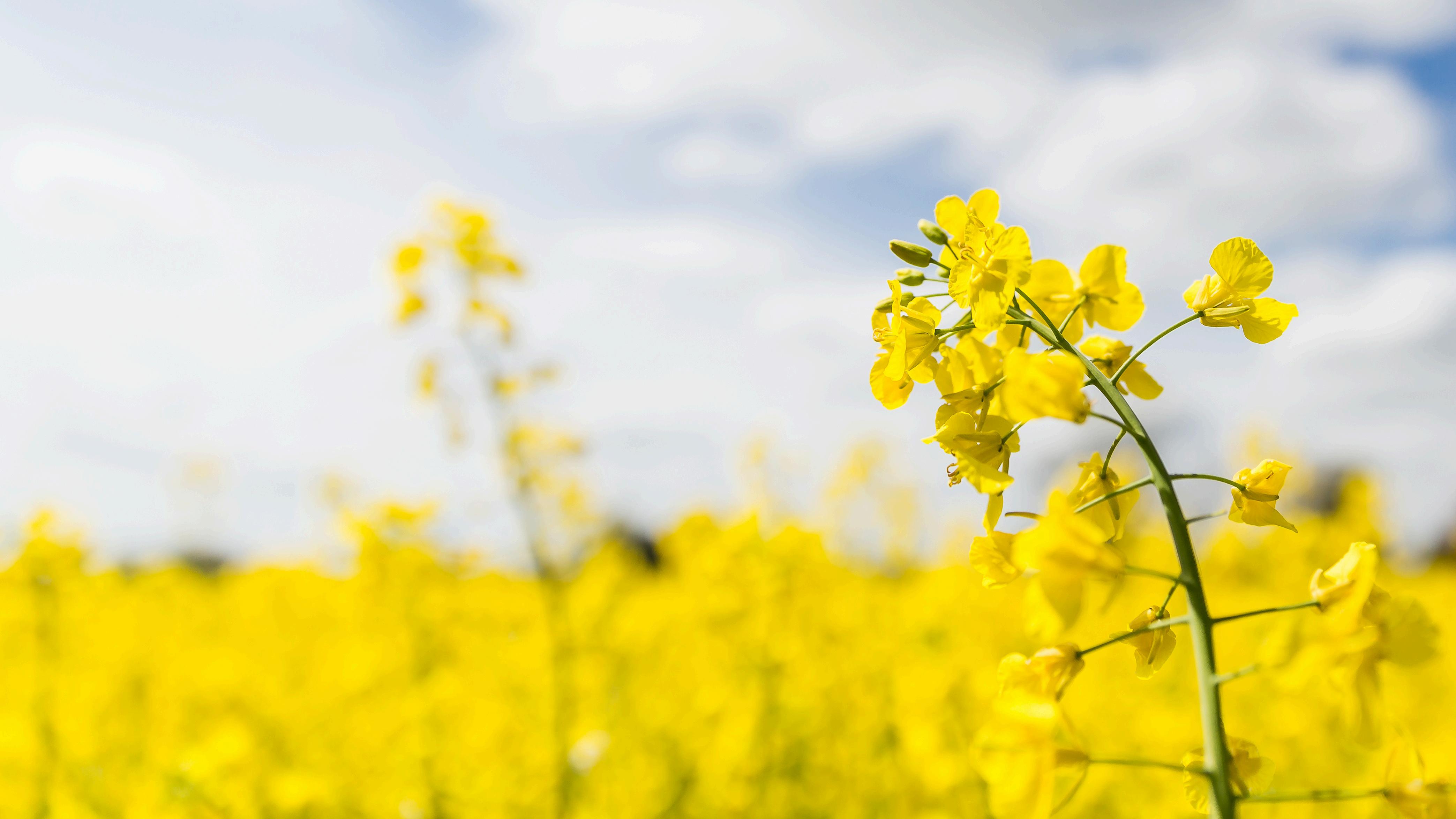
Growers in the region have had a much better time of growing rape this year as opposed to 2023. After an extended flowering period, crops seemed to have a successful pod set and are still standing. Despite average levels of sunshine in June, continued dull weather may compromise grain fill and, therefore, yield. More wet weather means that a timely desiccation will be important in ensuring everything is fit to harvest when conditions are right.
After a difficult start to life, winter bean crops are now standing tall as they start to senesce. The green area is now reducing, but crops have not suffered from significant levels of disease. Similarly to the oilseed rape, an extended flowering period has led to good pod set along the stem.
Crops seem far less affected by black bean aphid damage compared with the previous season where numbers were remarkably high in June. Again, many of these crops will have a substantial broadleaf weed burden below the canopy, and a pre-harvest glyphosate could assist with harvest efficiency. It is a worthwhile reminder that seed crops should not be treated with glyphosate pre-harvest so as not to compromise viability.
Both vining and combining peas have not had the easiest start, with slow emergence leaving them susceptible to feeding damage from a range of pests. Like beans, broadleaf weed chemistry is limited post-emergence in peas, and growers may have significant amounts of green matter to contend with.


Sugar beet drilling was slightly delayed due to conditions this year, but seed bed quality must be considered a greater priority for beet than sowing date. For the most part, growers were able to carry out their residual applications in a timely fashion.
Duller conditions actually created greater windows for application, reducing the chance of scorching the crop. Aphid threat was high throughout the season, and from 1st June, emergency approval was granted for the use of Insyst insecticide for non-Cruiser SB treated crops.
At this time, the aphid threat has reduced, and monitoring has stopped. Growers will now be turning their attention to fungicide applications. The BBRO forecasts are favouring the development of Cercospora Leaf Spot at this time, so growers should be ready to treat with effective chemistry.
It’s a similar story in the west of the country; winter wheat varieties have been pushed hard for Septoria, with conditions remaining wet throughout the spraying period. There are obviously varietal differences, but drilling date appears to be the driving factor around disease pressure. There is always a pay-off with drilling earlier, however, those drilled-up by mid-October would most likely run that risk again given the season.
The demand for forage will generally remain high, with animals being housed for longer than they ordinarily would and continued development in anaerobic digestion (AD) plants. A big worry for maize growers can often be a lack of soil moisture during establishment – this has not been such a concern for sowing this time around. In saying this, establishment was generally slow, with clay soils taking a long time to reach optimum temperature with the constant rainfall.
After some welcome sunshine, things have progressed, and broadleaf weed control has been effective where applications were timely and targeted at small plants. Growers should ensure that all herbicide applications are carried out before the eight true-leaf stage and before the buttress roots are visible.
Similarly to the maize, the cold, wet spring meant that growth was slow, delaying the first cut of silage. Since then, warm and showery conditions have been conducive to good grass growth.
There was also a reasonable window in June for haymaking to be carried out. Hopefully, advantageous conditions continue to ensure that not only yield is high, but that quality is right for fermentation and animal nutrition.
Cutting date is key to meeting the demands of silage for your business and, therefore, close attention should be paid to ear-emergence, particularly whilst crops are racing through growth stages.
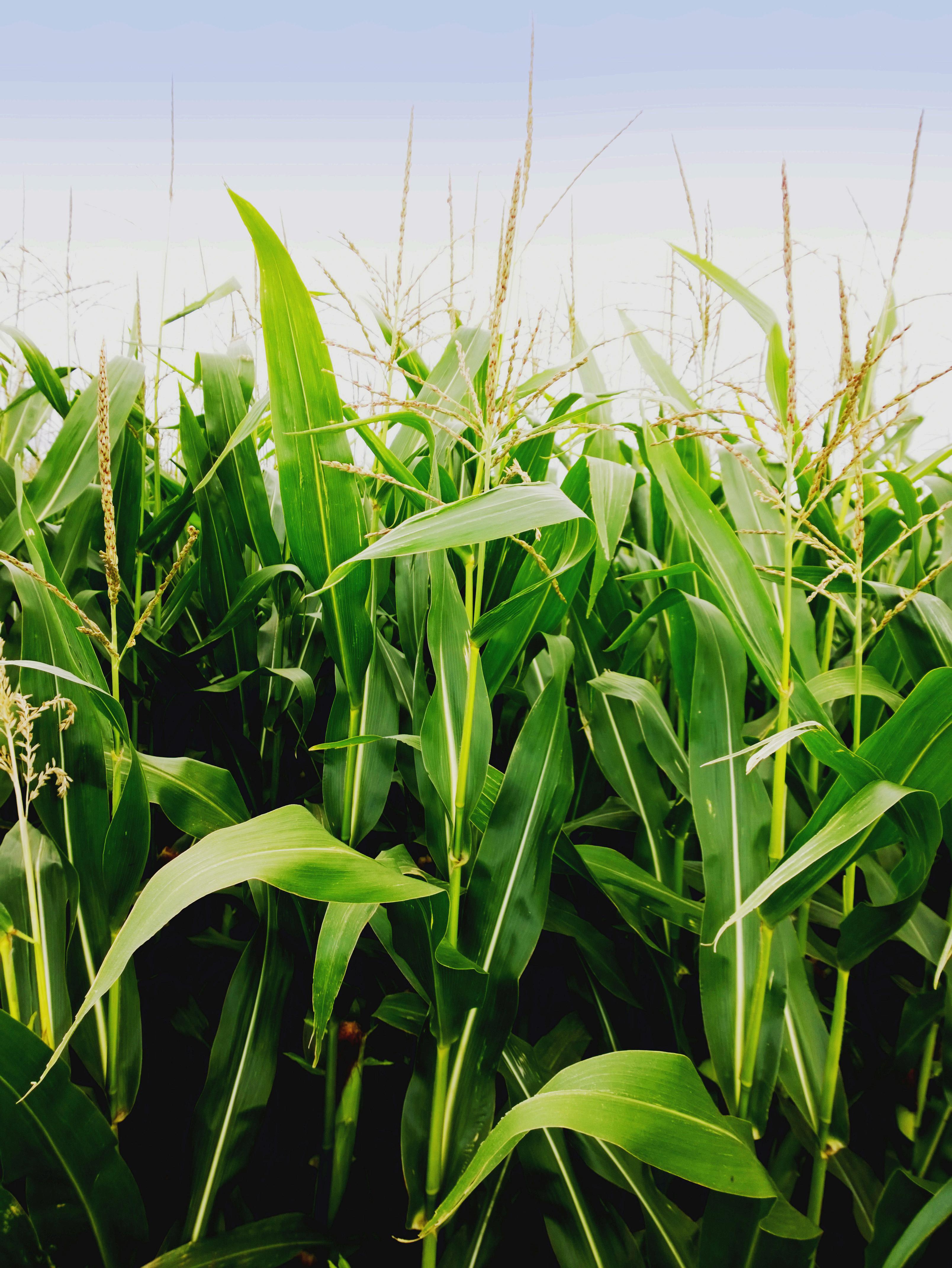
SIMILARLY TO THE MAIZE, THE COLD, WET SPRING MEANT THAT GROWTH WAS SLOW, DELAYING THE FIRST CUT OF SILAGE. SINCE THEN, WARM AND SHOWERY CONDITIONS HAVE BEEN CONDUCIVE TO GOOD GRASS GROWTH. THERE WAS ALSO A REASONABLE WINDOW IN JUNE FOR HAYMAKING TO BE CARRIED OUT HOPEFULLY, ADVANTAGEOUS CONDITIONS CONTINUE TO ENSURE THAT NOT ONLY YIELD IS HIGH, BUT THAT QUALITY IS RIGHT FOR FERMENTATION AND ANIMAL NUTRITION CUTTING DATE IS KEY TO MEETING THE DEMANDS OF SILAGE FOR YOUR BUSINESS AND, THEREFORE, CLOSE ATTENTION SHOULD BE PAID TO EAR-EMERGENCE, PARTICULARLY WHILST CROPS ARE RACING THROUGH GROWTH STAGES.

The details around the new Expanded SFI 2024 offer have been released, with applications officially open from 22nd July.

Those wishing to apply sooner can fill out an expression of interest. Ceres Rural is already undertaking applications for those who have been invited for early entry via their completion of this form. New entrants and previous nonclaimants of BPS can now apply.
The new offer incorporates the existing SFI 2023 options, and Countryside Stewardship into a single scheme. There are many similarities to the current SFI 2023 offer, including:
Payments made quarterly from month four
Three-year option durations
Tenant-friendly
25% cap on certain non-food-producing options.
There are also several new options available to applicants which include:
PRF1:Variable rate application of nutrients £27/ha. This is rotational but must be all nutrients including organic manures, i.e. using a variable rate file or crop sensor.
SOH1:No-till farming £73/ha. Non-rotational, but strictly no conventional or shallow cultivation, only stubble rake/straw harrow with rear facing tines. Low disturbance subsoiling can be done where justified e.g., wet weather at harvest.
TSOH3: Summer cover crop £163/ha. Sow June-Aug. Cannot be harvested or grazed (except for destruction). Destroy no less than two weeks before sowing cash crops.

WBD1: Management of ditches (or lack thereof!) £4/100m. Cut vegetation no more than 50% per year, clean out ditch no more than one year in three.
WBD1: Management of ditches (or lack thereof!)
£4/100m. Cut vegetation no more than 50% per year, clean out ditch no more than one year in three.
AGF2: Maintain low density agroforestry
£385/ha, which can be used on other ELM options e.g. Herbal Ley.
BND1: Maintain dry stone walls
£27/100m for both sides. The main requirement being to keep them in good repair.
Some of the existing SFI 2023 options also have subtle differences under the Expanded SFI 2024 offer:
CNUM3: Legume fallow £593/ha. If you are establishing in year one the option is now ‘static’ and must stay in the same place for the three years, if you are looking for a spring sowing and removal in the same year, then SOH2 or 3 (summer cover crops) are recommended.
CSAM3: Herbal ley £382/ha. This is also static if establishing in year one, and the aims of the action now include producing flowering plants from late spring and during summer months.
For those in an existing HLS or CS Mid-Tier, there will be the mechanism from September 2024 to transfer into an SFI or CS Higher Tier, potentially simplifying the administration.
There will be further developments to come this Summer, in the shape of furtherdetails around new CS Higher Tier applications and new ‘premium payment’ actions. For example, the 10-year ‘connect river and floodplain habitats’ for £1,242/ha (which will require Natural England endorsement).
Overall, whilst the intention is to simplify applications and claims going forwards, it is more important than ever to read the detailed guidance and take advice to effectively navigatethe differences between SFI 2023 and SFI 2024 to ensure a new scheme fits your system of farming.

In the early hours of Friday 5th July, the widespread predictions from Britain’s political landscape were confirmed: Sir Kier Starmer and the Labour Party won the general election and achieved a substantial majority in the process.
Though unsurprising, a change in government has courted much uncertainty amongst the rural and farming community in what has already been a turbulent and challenging decade. Volatility in commodity prices, inflation, uncertainty around domestic food production, married with the prospect of losing the Basic Payment Scheme (BPS) have all rocked agricultural businesses to varying degrees. In addition, roll-out of Defra’s Environmental Land Management Schemes (ELMS) has not been without its complications. With all this in mind, concerns around further change are well justified. As a reminder, the key take-homes from Labour’s manifesto with regards to agriculture are as follows:

2.
1. Local Food Production and Environmental Standards: Targets have been set for at least 50% of food used within the public sector to be produced locally and to of higher environmental or welfare standards. An emphasis on domestic food production should be welcomed, provided that sufficient mechanisms are in place to allow businesses to continually invest in the production aspect of their business.
3.
Environmental Land Management (ELM) Scheme: Labour has committed to continue with ELMS. Hopefully, this will bring some comfort to farmers and land managers who have already dealt with several iterations and U-turns within the schemes.
Budget Commitments and Funding: Labour has not made specific funding commitments to the sector at this stage. Whilst they did not state the size of the pot, this does not mean that there will not be one.
It is fair to say that Labour’s manifesto was ‘light-touch’ on agriculture. Kier Starmer has named Steve Reed as the new Defra secretary and Daniel Zeichner as Farming Minister. We look forward to hearing from them as they settle into their new roles. As it stands, farmers and land managers should continue to make the most of existing funding channels which are business as usual for now. In her first speech to the British people after taking on the role as Chancellor, Rachel Reeves set-out her dogged ambitions to free-up planning regulations to enable a landmark delivery on house building and onshore wind farms. With this comes greater competition for land and shifts the dial slightly for land-use and its priorities. We shall see where agriculture sits in amongst it all in the months to come.
BTV continues to pose a threat to sheep, cattle, goats and deer in UK after the cases were found in the South East in summer of 2023. Encouragingly, a vaccine has been authorised for use in the Netherlands, although there are still a number of unanswered questions as to its efficacy in practical terms. As conditions continue to get milder, the threat of midge-born viruses will increase, making robust vaccination development and programmes essential for future safeguarding.
Blue Tongue is a notifiable animal disease. If you suspect it, you must report it immediately. Failure to do so is an offence. Report in:
England – call the Defra Rural Services Helpline on 03000 200 301
Wales – contact 0300 303 8268
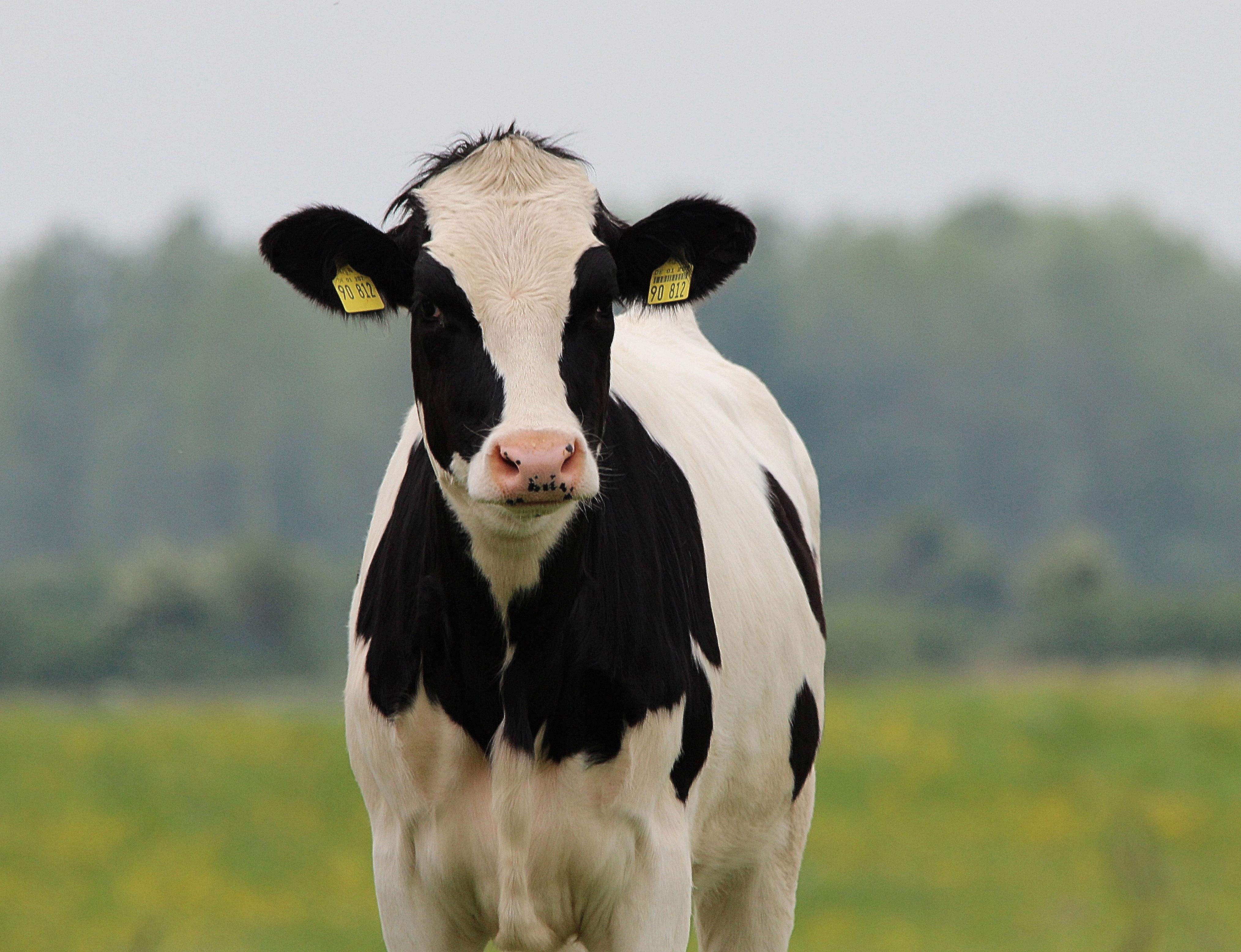
Defra set-out a 25-year eradication strategy for TB, and (said tentatively), it appears to be working. It has taken significant lobbying from key stakeholders over a number of years to get to the point where Westminster understands the devastating impacts of the disease and to support its eradication.
With this in mind, Labour’s manifesto claims that the badger cull is “ineffective” worried those who have advocated so tirelessly for government backing on this issue. The cull aside, let’s hope that memories are not too short, and the new raft of MPs representing rural constituencies in Westminster continue to support an eradication in its most effective form.

As ever, since our last update in March, the markets have been volatile. The end of February saw what can (currently) be described as the trough, with Nov-24 futures getting to below £180/t. Fortunately, we have seen some uplift since. The second half of May has seen the most recent peak of £223/t (Nov-24 futures, which even managed to drag up feed barley prices back from the doldrums of £140/t ex-farm, to just shy of £190/t). However, we have seen prices fall back, with Nov futures at the time of writing sitting at £195/t.
In essence, from May 22 markets had largely been on the slide, so the latest rally, albeit now with the shine taken off it, has been welcome relief.

The outlook is even starting to be more positive for rapeseed, with Nov 24 futures increasing from €414 in February to €514 at the start of July – a welcome increase that now sees ex-farm prices just under £400/t off the combine. With average yields in recent years being under 3t/ha, this still doesn’t result in gross margins comparable to that of feed wheat; however, it does show that there is some money to be made.
Most farmers have committed c.30% of wheat forward, with an average price just north of £200/t. Sentiment amongst farmers seems to be to sit tight until harvest is completed.

Source: Merchant East Anglia ex. farm bids (as of July 9th 2024)

Figures recently released by the Health & Safety Executive (HSE) show there were 32 fatalities in the year to 31st March 2024, with May 2023 being the single deadliest month (11 fatalities) for 15 years. In the run up to harvest, the following ten-point plan should be considered:
Fixed Equipment: intake pits, elevators, conveyors, grain dryers, stores and silos should be safe working environments. Hardwire electrical safety should be tested, buildings cleaned to remove dusts and mould, external and internal lighting checked for working order, and any broken or damaged asbestos addressed. Sliding and roller shutter doors should be easily operable, guards in place during operation, and systems shut off and isolated before carrying out repairs or maintenance. Silos should be thoroughly ventilated and a breathable atmosphere proven prior to entry, with staff trained in working in confined spaces, using appropriate respiratory and personal protective equipment, with at least two people present at all times.
Machinery: all items of machinery must be kept in efficient working order and in good repair. Adopt the airline pilot mentality of pre-flight checks: lights, beacons, windows, mirrors and tyres should be clean and in working order. Tractors cabs should not contain tools or spare parts which could inhibit the operation of machinery, or create a hazard to the operator.
3.
Trailers: trailers exiting hibernation should be thoroughly inspected and daily checks carried out. The Tilly Pass Scheme meets the specification of the new British Standard BS14200:2023. It was published in November 2023 and covers all powered or manual machinery, and associated components, that employers provide for use in their businesses, and which they have a legal duty to maintain under the Provision & Use of Work Equipment Regulations 1998 (PUWER). The Tilly Certificate provides a tangible, documentary record of trailers being correctly maintained. Further information is available on the Head to Tow trailer safety App from Google Play or the App Store: Tilly Pass. Head to Tow. Operators should be certain that nobody is in the vicinity of trailers before operating hydraulic tailgates.
4.
Gateways: all farm and field gateways should be cut back to maximise visibility for operators. The topper and hedge cutter should be despatched before harvest to make field entry and exit points as readily navigable as possible with ditches, gate posts, telegraph poles and other features clearly exposed. Vegetation at regularly used road junctions should be similarly trimmed back so operators have clear visibility in both directions.


Overhead Power Lines: plans of overhead power lines should be given to all staff and the maximum working height of machinery (particularly the combine harvester and tele-handlers) displayed in the cab. There should be no combine unloading, trailer tipping or bale stacking within a 10m horizontal distance of overhead power lines. It should be noted that power lines decrease in height during the heat of the day when the conductor material expands. If using GPS, consider plotting overhead power line routes into Greenstar, Trimble or similar systems, with an audible alert in the cab when machinery comes within a 10m distance of these lines. Ensure that all staff receive a pre-harvest health and safety briefing which explains what to do – and what not to do – in the event of hitting an overhead power line. In an emergency, contact the local network distribution operator by dialling 105.
Bales: bales should be safely handled and transported and securely stacked in appropriate locations. Trailers should not be overloaded, bales must be secured and straps or ropes rechecked before leaving the field. Stacks should be constructed on firm, dry, level and freely draining ground, with space for tele-handlers and tractors to manoeuvre. Bales should be ‘tied in’ such that lower supporting bales are stabilised by overlapping and interlocking upper bales in alternating layers. Stacks should have a wide base that narrows slightly as the height increases. Stacks should be monitored for good condition, to check for bales coming loose or danger of collapse, and for activity by trespassers. Use signs to instruct people to keep clear of bale stacks at all times. Follow the guidance produced by the HSE: Safe Working With Bales INDG125
Fire: provision should be made for fighting farm fires. Despite the wet conditions of recent months, hot and tinder dry conditions remain a possibility at harvest. Ensure machinery is regularly blown down, cleaned, lubricated and well maintained to reduce the risk of fires. Use What3Words to pinpoint fire locations and farm and field access points for emergency services. Know where water supplies are and ensure hydrants are clearly marked and accessible: in an emergency, these may be on your own or someone else’s land. Make contingency arrangements including water tankers and cultivators to implement fire breaks, but beware of smoke fumes and changes in wind direction and do not put yourself in danger. Avoid storing bales near main roads to deter would-be trespassers and arsonists. Check the Met Office’s Fire Severity Index (FSI) which is not an assessment of the risk of fire occurring, but an assessment of likely severity if a fire were to start: FSI - Met Office
Vehicles & Pedestrians: take reasonably practicable steps to segregate vehicle and pedestrian traffic. Unexpected visitors to farm yards during harvest can include grain samplers, machinery fitters, collection and delivery drivers, family members, and tenants of let commercial and residential properties. Be vigilant of pedestrians and ensure they keep to designated routes and crossing points where present. Use Safe Stop when leaving the cab of machinery.

Ensure grain store operators stand well clear of trailers when reversing and tipping, and aim for everyone apart from the operator to stand well clear of the combine harvester when hitching and unhitching the header. Do not approach, mount or dismount the combine harvester for any reason while it is moving or in operation.
Children: be vigilant of children in farm yards and fields, especially during school holidays. Children can be easily tempted into these environments – all farm staff should have the autonomy and authority to politely return them to a place of safety and alert a parent or guardian. If you have time, this is a great opportunity for positive engagement and education about farming, but do so once the child is safe and not in the working environment.
Wellbeing: your people are your most fundamental asset. Harvest is a time of new hazards, increased risk, unfamiliar and lesser trained and experienced staff, working in darkness, and under greater mental strain. While the harvest team may work closely together, others who are cultivating, mowing or hedge cutting may be lone working and should be checked on regularly. Staff should be aware of the risks of and control measures for sunstroke, heatstroke and dehydration. Harvest can cause additional stress and support should be sought if required:
You Are Not Alone: YANA: You Are Not Alone – Rural Mental Health Support
Yellow Wellies: Farm Safety Foundation / Yellow Wellies 9. 10.

Tendering Show – 13th July
Aylsham Show – 26th August
Moreton in Marsh Show – 7th September
East Kent Ploughing Match – 25th September
Cheshire Ploughing Match – 25th September
Farm Business Innovation Show – 6-7th November
IAgrM Conference – 7th November
Croptec – 27-28th November
IIf you would like to discuss any of the topics covered in this issue of the Farming Update, do contact a member of the Team, or speak to the project leader, George Catchpole, via the details adjacent.

george catchpole@ceresrural co uk 07928 667 899